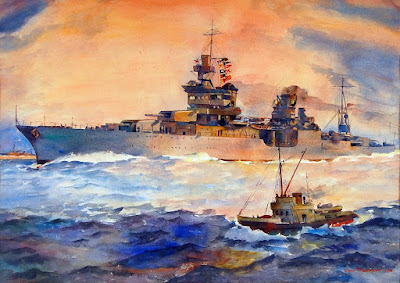Happier Times: USS Indianapolis before World War II
USS Indianapolis (CA
35) is a ship whose name will be familiar to any student of World War II. After
delivering the atomic bomb to the island of Tinian on 26 July 1945, she set a
course for Leyte Gulf to join with the rest of the U.S. fleet in preparing for
the invasion of Japan. Just after midnight on 30 July, the Japanese submarine I-58 spotted Indianapolis and fired six torpedoes. One hit the bow and the other
struck amidships next to the fuel tank and magazine. Within minutes, an
explosion ripped the ship apart. Of the 900 men who made it into the water,
only 317 were rescued after a five-day ordeal that subjected them to exposure,
starvation, thirst, and shark attacks.
It is unfortunate that this tragic end overshadows other
events from earlier in the ship’s fourteen-year operational history. Prior to
World War II, Indianapolis carried
out an important diplomatic duty when she transported President Roosevelt to
the 1936 Pan-American Conference in Buenos Aires. Captain Henry Kent Hewitt
assumed command of Indianapolis in
March of that year. The cruiser sailed to Panama for tactical exercises before
returning to the east coast where she operated through the fall. On 18 November,
Roosevelt boarded Indianapolis in
Charleston, SC, following installation of a special elevator for the
President’s wheelchair. USS Chester (CA
27) served as an escort and sailed in the lead during the voyage south to
prevent any possibility of the President’s ship being involved in a collision.
 |
Thirty-Five
Knots, USS INDIANAPOLIS
Arthur
Beaumont, 1936
Gift
of Mrs. Floride H. Hewitt to the Naval War College Foundation
NWCM
1973.06.01
|
Given Roosevelt’s strong naval background (he served as
Assistant Secretary of the Navy from 1913-1920), it is not surprising that he
took a strong interest in the ship’s activities. Hewitt recalled one such
instance as the ship set out from Charleston:
Commander Badger reported the
ship ready for getting under way and the lines singled up. Just as we let go,
and the ship began to move ahead, two bells were struck. Later, as we left the
harbor and steadied on our southerly course, the president commented to me,
"Skipper, I noted that you were right on the bell." He knew nautical
terminology and liked to be treated as a flag officer. Throughout the cruise,
he had charts—with courses plotted—parallel rulers, and dividers in his
admiral's cabin, and he was always furnished with the 8 a.m., noon, and 8 p.m.
positions, which he plotted and checked.
 |
LZ
127 Graf Zeppelin over Rio de Janeiro
Undated photograph
|
Indianapolis ran
on a tight schedule and maintained an average speed of 25 knots in order to
ensure that Roosevelt reached the conference on time. They had two notable
encounters along the way – one with the German airship Graf Zeppelin on its way home from Brazil, and another with a
German cruiser whose crew manned the rails and fired a twenty-one gun salute. Both
events, though peaceful, underscored Germany’s growing interest in South
America.
 |
President Franklin D. Roosevelt speaking
before King Neptune’s court
during the crossing the line ceremony on USS Indianapolis
Photograph courtesy of FDR Library
|
On 24 November, Indianapolis
observed the traditional “crossing the line” ceremonies as the ship passed over
the equator. King Neptune’s court arrived in full regalia and proceeded to put
the ships’ pollywogs – those who were crossing the equator for the first time -
through the usual initiation rituals. President Roosevelt, himself a pollywog,
was spared from the harsh treatment that accompanied these ceremonies, but he
insisted on appearing before King Neptune in keeping with the spirit of the
day. His only punishment was to explain to the crew over the ship’s public
address system why he had lost the states of Vermont and Maine in the recent
presidential election.
Indianapolis
reached the harbor of Rio de Janeiro the day after Thanksgiving. Somewhat to
Hewitt’s embarrassment, rough seas had washed away patches of the ship’s paint
causing Indianapolis to enter the
harbor with bare spots on her hull. If Roosevelt was displeased, he did not
mention it. They continued on to Buenos Aires and arrived two days early for
the conference, a testament to the ship and its crew. Hewitt was promoted to
rear admiral in 1939 and commanded naval forces that supported Allied landings
in the Mediterranean Theater during World War II. He served as an advisor at
the Naval War College during his tenure as Commander, U.S. Naval Forces Europe,
after the war. The College honored him in 1976 by naming Hewitt Hall in his
honor.
Rob Doane,
Curator, Naval War College Museum


Comments
Post a Comment